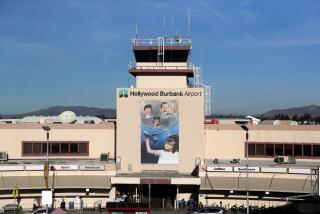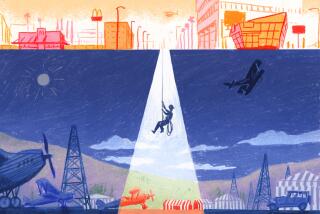David Simmons, 90; Managed Burbank Airport for Decades
- Share via
The scene was electrifying to a 14-year-old boy who had flown with his pilot father from Santa Monica to witness the official opening of Burbank’s United Airport in May 1930. Dozens of bombers, fighters and other planes were revving their engines for a ground-rattling flyby.
It was like “Disneyland and the greatest Fourth of July rolled into one,” David M. Simmons, who turned his boyhood fascination with aviation into a career, told The Times 60 years later.
By then, his personal history had long been entwined with what is now known as Bob Hope Airport.
Simmons spent almost four decades managing the airfield for a Lockheed subsidiary and oversaw the airport’s sale in 1978 to the Burbank-Glendale-Pasadena Airport Authority.
Simmons, 90, died Sept. 2 from injuries suffered in a Beverly Hills automobile collision, said Viggo Butler, who succeeded Simmons as president of Lockheed Air Terminal in 1984.
The cause of the accident, in which Simmons died at the scene, was under investigation, the Beverly Hills Police Department said.
“He was one of the last remaining bridges to the glory days of aviation,” Butler said. “He was one of the last people around who knew Howard Hughes and Amelia Earhart.”
When Simmons went to work at the airport in 1946, it was run by and known as Lockheed Air Terminal.
As air travel became more popular, the major airlines’ needs expanded, and they moved on to what is now Los Angeles International Airport.
“We had something like 600 acres here and Los Angeles had about 2,900,” Simmons told The Times in 1990. “And the airlines needed longer runways and more parking, so they left.”
By the time Simmons had attained the presidency of Lockheed Air Terminal in 1968, the Burbank airport had reemerged as a base for major airlines because newly developed jet aircraft could use the airport’s shorter runways, Butler said.
Whenever an aviation milestone was celebrated, Simmons could be counted on to remind the public of the Burbank airfield’s place in history.
“No other privately owned airport in the U.S., and perhaps the world, handled such a large number of air travelers during its private-status days,” Simmons said in a 2003 speech marking the centennial of flight.
David Maney Simmons was born Feb. 16, 1916, in Springfield, Mo., and moved to Beverly Hills when he was 5.
He was the son of an oil wildcatter who also worked in real estate.
At 7, Simmons experienced his first plane ride and later rode in a plane with aerial cameraman Elmer Dyer, who was working on the 1930 Hughes film “Hell’s Angels.”
After graduating with a degree in business and finance from USC, Simmons earned a management degree from Harvard Business School and joined Douglas Aircraft Co. in 1939.
At the outset of World War II, the company sent him to East Africa to help build a strategic airport that was heavily used by Allied forces. During the war, he also served in the Navy.
Simmons is survived by his wife of 65 years, Barbara, and by a sister in San Francisco.
“He was the most gregarious and pleasant of people,” Butler said, “a raconteur with a movie-star presence who always had a story to tell.”
*
More to Read
Sign up for Essential California
The most important California stories and recommendations in your inbox every morning.
You may occasionally receive promotional content from the Los Angeles Times.














